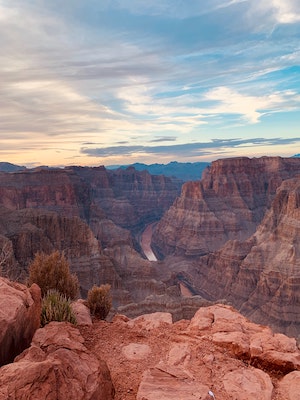Province guides

Attractions
Arizona is home to some of America's most striking natural landscapes, making it one of the best road tripping destinations in a country. The iconic Route 66, or the Main Street of America as it became known, still attracts droves of travellers. The state boasts some renowned natural sights, including Saguaro National Park, the Petrified Forest National Park, and the famous Grand Canyon National Park.
Unique physical features in Arizona include Monument Valley, setting the scene for many a cowboy movie; Cathedral Rock and the other peaks that form the backdrop to the desert town of Sedona; the 40,000-year-old Barringer Crater, the best preserved impact crater on Earth; the Canyon de Chelly, full of otherworldly sandstone formations; and the breathtakingly blue Havasu Falls of the Grand Canyon.
The surprisingly colourful desert landscapes are interrupted by Wild West-style towns, old mining centres, and Native American reserves. The old world charm is punctuated by the popular, sprawling cities of Phoenix and Tucson, full of resorts and top-quality modern amenities. Phoenix and Tucson, as well as charming Sedona, are full of interesting sightseeing attractions and act as the natural travel hubs for visitors to the state.

The Grand Canyon
A mile deep, 277 miles (446km) long, and up to 18 miles (29km) wide, the breath-taking grandeur of the Grand Canyon is so impressive that words simply cannot do it justice. One of …
The Grand Canyon
A mile deep, 277 miles (446km) long, and up to 18 miles (29km) wide, the breath-taking grandeur of the Grand Canyon is so impressive that words simply cannot do it justice. One of the great natural wonders of the world, it was formed by the cutting action of the Colorado River over millions of years. The hard rock formations survive as great cliffs, pinnacles and buttes, and the different layers of rock span a range of colours, from purple, fiery-red and pastel-pink to yellow, brown, grey and soft tones of blue.
Whether by foot or on horseback, from a plane or helicopter, aboard a raft down the mighty Colorado River or by merely gazing in awe from the rim, the canyon's seemingly infinite depths can be experienced in a variety of ways and is a sight not to be missed however visitors choose to see it. The park receives hordes of visitors from around the world, who never fail to be transfixed by the sculpted rock shapes, the shifting colours that change with the light, and a tiny glimpse of the Colorado River far below.
The Grand Canyon National Park comprises two separate areas: the South Rim and the more remote North Rim. Separated by the 10-mile (16km) width of the canyon, it is a 215-mile (346km) drive from one Visitor Centre to the other. The South Rim is the most accessible and has more facilities, and as a result it attracts the bulk of visitors to its boundaries. The North Rim is higher in elevation, wetter, with thicker surrounding forests, is more remote, and is cut off by snowfall from October to May. Many people, however, prefer its comparative peacefulness and less-crowded lookouts.
Grand Canyon West has recently opened the Grand Canyon Skywalk, a glass-bottomed, horseshoe shaped deck that juts almost 70 feet (21m) from the canyon's rim. It gives visitors the sensation of being suspended amid the canyon's towering red rock walls above a faint sliver of Colorado River flowing 4,000 feet (1,219m) below. There is an additional charge for the Skywalk, which is not for those with a fear of heights. Another great way to tour the Grand Canyon is on the Grand Canyon Railway, a vintage steam train that winds its way around the area.
Both rims have numerous drives and walkways along the edge with various scenic viewpoints, and some hiking trails into the canyon where visitors can overnight at Phantom Ranch on the canyon floor. The impact of more than four million visitors a year to the South Rim, especially during the busy summer months, is one of overcrowding and traffic congestion; but seeing the most spectacular examples of natural erosion in the world more than makes up for any inconvenience.
There are also several educational and cultural attractions at the Grand Canyon, including the Tusayan Museum and Ruin (near Desert View), the Yavapai Museum of Geology, and the Verkamps Visitors Center.
Website www.nps.gov/grca


